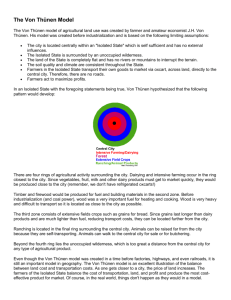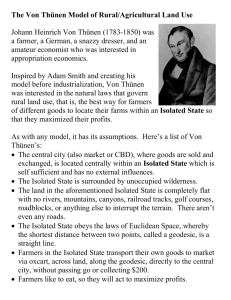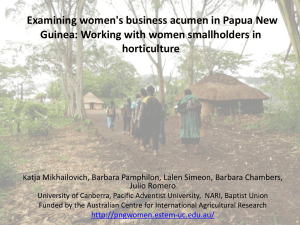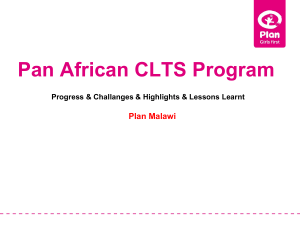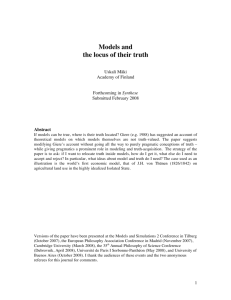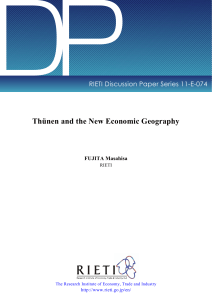Nucleated settlement patterns are.
advertisement
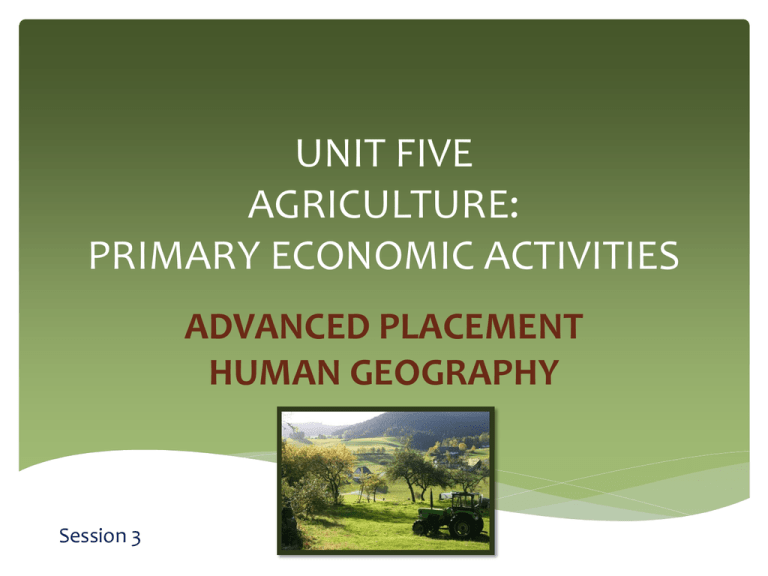
UNIT FIVE AGRICULTURE: PRIMARY ECONOMIC ACTIVITIES ADVANCED PLACEMENT HUMAN GEOGRAPHY Session 3 RURAL LAND USE AND SETTLEMENT PATTERNS THE VON THÜNEN MODEL Johann Heinrich von Thünen, a German farmer, developed a famous model for rural land use in the early 19th century. He studied the space around Rostock, Germany. Von Thünen’s model was the FIRST effort to analyze the spatial character of economic activity. Von Thünen published his model in The Isolated State in 1826. THE VON THÜNEN MODEL Von Thünen noticed a pattern on the landscape as one crop gave way to another. There was no visible change in: soil climate terrain THE VON THÜNEN MODEL Each town was a market center surrounded by a set of roughly concentric rings that featured different crops. Von Thünen identified four rings that surrounded market centers. THE VON THÜNEN MODEL RING ONE: Market gardening and dairy Nearest to the town Perishable products Expensive to deliver and must reach market quickly Examples: garden vegetables milk THE VON THÜNEN MODEL RING TWO: Forest Source of fuel and construction Trees heavy to transport THE VON THÜNEN MODEL RING THREE: Field crops Used for less perishable crops Crops rotated yearly Examples: wheat other grains THE VON THÜNEN MODEL RING FOUR: Animal Grazing The outermost ring was devoted to livestock grazing. Grazing requires much space. Beyond this ring, it generally became unprofitable to farm commercially because the transportation costs became too high. Intensive v. Extensive Agriculture Intensive Agriculture Intensive agriculture methods needs to be applied in the rings that are closest to the market center. Land closer to the market center is subdivided into relatively small units. Dairy and truck farmers sought smaller plots of relatively expensive land close to cities. Extensive Agriculture Land far from markets in rings three and four may be farmed extensively and in larger units. Grain farmers and ranchers settled on larger, less expensive land farther away from urban areas. LOCATION THEORY Location theory explains how an economic activity is related to the land space where goods are produced. Von Thünen identified the interplay of transportation costs and value of the products on rural land use. This connection is still at the heart of location theory. TRANSPORTATION Von Thünen’s model comes in to play in assessing rural land use for organic foods. Example: On a regional level, fresh organic chicken served in a New York City restaurant would most likely have a more limited area of profitability than chicken that is non-organic. ON A GLOBAL SCALE… Von Thünen’s model is useful for understanding broad patterns of land use. Factors that affect rural land use include: varying climate various soil conditions farming methods technology historical influences ON A GLOBAL SCALE… Many poor countries today still grow commercial crops – such as coffee and bananas – on soil that might be used for food for their own consumption. The historical roots of this practice are in colonial times, when plantations were used for commercial agriculture by European countries and/or the U.S. PATTERNS OF SETTLEMENT What affects density of housing in rural areas? Dispersed settlement patterns These patterns are found in areas where extensive agriculture is practiced. Individual farmhouses lie far apart. They may also exist in areas where machinery makes intensive cultivation of large areas possible. What affects density of housing in rural areas? Nucleated settlement patterns Villages are located close together with small surrounding fields. Land use is intense, but people and animals do the work. This is the MOST common pattern of agricultural settlement. What affects density of housing in rural areas? Nucleated settlement patterns Here you will find houses grouped together in hamlets, or small clusters of buildings. Slightly larger settlements are called villages. These settlements reflect the historical need to band together for protection. HOUSING STYLES AND GEOGRAPHY Geography and Housing Geography has always influenced the types of houses that people build for shelter. Examples: People in flood-prone areas learned how to build houses on stilts. People in areas with lots of snow learned to build steep-sided roofs. Geography and Housing Lifestyles have also determined house styles. Examples: Light-weight transportable materials are used by nomadic people for shelter. Geography and Housing Until recently, people were limited by their physical environments in their building materials for housing. Example: Early settlers in the Midwestern U.S. built sod houses because trees were not readily available. Geography and Housing Today migrations have carried housing styles far away from their origins. Building materials are shipped for long distances. As a result, many areas have mixed housing styles. Housing Styles and Rural Areas Rural areas tend to have more traditional housing than urban areas do. Villages have mixtures of traditional and modified housing. Traditional Housing in Rural Areas Examples: Sod-covered roofs in Scandinavia Hand-cut stone houses in the Andes Mountains Mud-walled houses in China BUILDING MATERIALS Wood Historically, the use of wood has been linked to close proximity to forests. Wood is now shipped to most corners of the globe. BUILDING MATERIALS Wood The log house probably originated in northern Europe where forests were plentiful. The use of wood spread to North America when Europeans first settled there. BUILDING MATERIALS Brick In the U.S. bricks are oven-baked blocks of cement. In other parts of the world, brick is made from different materials. Today brick is a major element of modern construction all over the world. BUILDING MATERIALS Brick Sun-dried brick, wet mud mixed with straw, is used in many parts of the world including: the Middle East Northern China Mexico the southwestern U.S. BUILDING MATERIALS Stone Natural stone has long been used in home construction. Typically, natural stone is built with cement mortar. However, in the Andes Mountains buildings have no mortar and are stacked like puzzle pieces. BUILDING MATERIALS Wattle Wattle consists of poles and sticks woven tightly together and then covered with mud. Many African houses are constructed with wattle and a thatched roof. Other regions, such as Southeast Asia, may use bamboo, sticks, bark, and leaves for building. VILLAGES Villages The definition of a village varies throughout the world. It usually describes a small number a people who live in a cluster of houses in a rural area. Other structures found in villages include: government buildings markets places for religious gatherings Villages Another way to define a village is by the occupation of its people. Most people work in the primary economic sector as: farmers herders fishers specialized workers Village Forms Round village This type features houses that circle around a central corral for animals with fields extending outside the ring of houses. Round villages are found in East Africa Parts of Europe Why was this design developed? To protect domesticated animals Village Forms Walled village This type was developed in ancient days in order to protect villagers from attack. In Europe the villages were often surrounded by moats as well. Remains of a Village Wall • This photo shows the remains of the wall and an old city gate that led to the city of Die in France. • The wall provided protection from attack, and the gate was heavily fortified. Village Forms Grid village The grid village is more modern and is laid out in straight street patterns that run in parallel and perpendicular lines. It works best in areas with flat land. Village Forms Linear village This modern settlement follows major roads. There is often one single thoroughfare lined with: houses businesses public buildings Village Forms Cluster village This type of settlement may have more than one major road that inhabitants build along. It may also have housing that clusters around large public buildings such as: churches temples mosques grain bins livestock corrals THE INFLUENCE OF LAND OWNERSHIP AND SURVEY TECHNIQUES Land Ownership One of the most important influences on land settlement patterns is land ownership. Property lines divide one person’s land from another’s. Rules about property inheritance often determine land distribution. Land Ownership Primogeniture Primogeniture is practiced in areas where all land passes to the eldest son, resulting in land parcels that are large and tended individually. Primogeniture is found in: Northern and southern Europe the Americas South Africa Australia and New Zealand Land Ownership Survey methods Surveys were first used in areas where settlement was regulated by law. Example: The U.S. government used the rectangular survey system to encourage settlers to disperse evenly across interior farmlands. These grid-like patterns that were formed during this process are still found in the U.S. today. Land Ownership Other survey systems The metes and bounds approach uses natural features to mark irregular parcels of land. This approach has been used along the eastern coast of the U.S. Land Ownership Other survey systems The long-lot survey system divides land into narrow parcels that extend from rivers, roads, or canals. This system has been used in: Quebec Louisiana Texas Key Terms to Remember from this Session Von Thünen Model concentric rings perishable crops commercial crops dispersed settlements nucleated settlements hamlets villages primary economic sector round villages walled villages grid villages linear villages cluster villages primogeniture survey methods metes and bounds approach long-lot survey system
